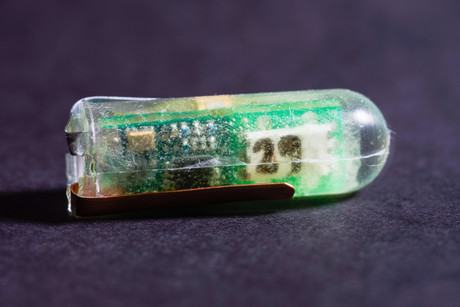Ingestible sensors powered by stomach acid

MIT researchers have designed a voltaic cell that is sustained by the acidic fluids in the stomach. Described in the journal Nature Biomedical Engineering, the system can generate enough power to run small sensors or drug delivery devices that can reside in the gastrointestinal tract for extended periods.
Senior authors Giovanni Traverso and Robert Langer had previously built ingestible devices that could be used to sense physiological conditions such as temperature, heart rate and breathing rate, or to deliver drugs to treat diseases such as malaria. These devices are usually powered by small batteries, but conventional batteries self-discharge over time and pose a possible safety risk.
To overcome those disadvantages, Langer and Traverso worked with fellow senior author Anantha Chandrakasan and lead author Phillip Nadeau, who specialise in developing low-power electronics. Together, the team took inspiration from a simple type of voltaic cell known as a lemon battery. This consists of two electrodes — often a galvanised nail and a copper penny — stuck in a lemon, whose citric acid carries a small electric current between these electrodes.
To replicate this strategy, the researchers attached zinc and copper electrodes to the surface of their ingestible sensor. The zinc emits ions into the acid in the stomach to power the voltaic circuit, generating enough energy to power a commercial temperature sensor and a 900 MHz transmitter.
In tests in pigs, the devices took an average of six days to travel through the digestive tract. While in the stomach, the voltaic cell produced enough energy to power a temperature sensor and to wirelessly transmit the data to a base station located 2 m away, with a signal sent every 12 seconds.
Once the device moved into the small intestine, which is less acidic than the stomach, the cell generated only about 1/100 of what it produced in the stomach. “But there’s still power there,” noted Traverso, “which you could harvest over a longer period of time and use to transmit less frequent packets of information.”
The current prototype of the device is a cylinder about 40 mm long and 12 mm in diameter, but the researchers anticipate that they could make the capsule about one-third that size by building a customised integrated circuit that would carry the energy harvester, the transmitter and a small microprocessor. Once the researchers miniaturise the device, they anticipate adding other types of sensors and developing it for applications such as long-term monitoring of vital signs.
“You could have a self-powered pill that would monitor your vital signs from inside for a couple of weeks, and you don’t even have to think about it,” said Nadeau. “It just sits there making measurements and transmitting them to your phone.”
Such devices could also be used for drug delivery, with the researchers demonstrating that they could use the power generated by the voltaic cell to release drugs encapsulated by a gold film. This could be useful for situations in which doctors need to try out different dosages of a drug, such as medication for controlling blood pressure.
“This work allows us to envision new medical devices where the body itself contributes to energy generation, enabling a fully self-sustaining system,” said Chandrakasan.
Avoiding EMC issues: simple tests you can do yourself
This is a brief overview of EMC compliance with some practical tips on not getting caught out.
Electric dump valves help oil and gas company reduce emissions
Oil and gas company Laramie Energy deployed ASCO zero-emissions electric dump valves to comply...
Australia's largest electronics expo returns to Sydney
Electronex, the annual electronics design and assembly expo, will return to Sydney on 19–20...






